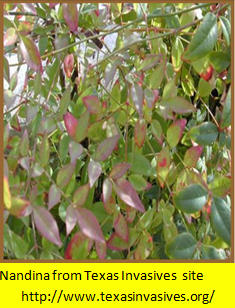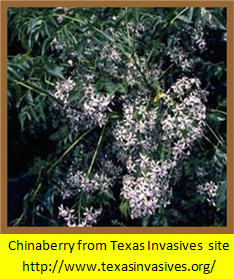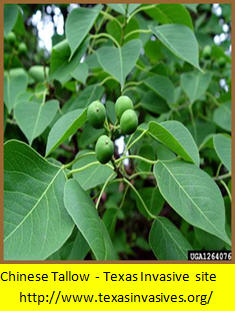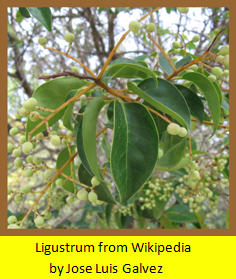Guide to SA Natural Areas & Greenway Trails
D. Exotic Invasive Plants
Alamo Area Master Naturalist Jessica Leslie is the author of this piece..
Note: This notice is required by HB 338, passed by the 2011 legislature. Any plant termed below as an invasive “is only a recommended [characterization] and has no legal effect in the State of Texas. It is lawful to sell, distribute, import or possess a plant [we term invasive] unless the Texas Department of Agriculture labels the plant as noxious or invasive on the department’s plant list.”


INVASIVES DRIVE OUT NATIVES
Exotic invasive plants are those plants that are not native to an area, but reproduce so readily that they establish themselves very quickly. Their rapid spread often causes harm to the environment by outcompeting the native plants in an area. Why is this a problem?
INVASIVES ESCAPE THE CONFINES OF OUR YARDS
The problem lies in the fact that other native species, such as insects, birds, etc., rely upon native plants as a source for food and shelter. If the invasive plants dominate an area, the native plants cannot survive. Without the natives, the insects and other species lose their food and shelter sources, and they, in turn, also cannot survive.
How did these invasive plants get here? Many of these plants were imported from other countries for their ornamental value and their resistance to insects and disease. Nurseries sell them as landscape plants, but, unfortunately, they do not remain in the confines of our yards. When they show up in a non-native area, they have no natural predators, thus they are able to reproduce without predation. The added fact that they are disease and insect-resistant only increases their survivability.
REDUCE DIVERSITY
When they take over an area and choke out natives, the other species such as the birds and insects no longer have a natural food source in the area, and so they move on. If an invasive plant becomes persistent over a large area, some animal species could become endangered or simply disappear. The end result is that native habitat becomes overrun with exotics and not only do our native plants disappear, but so do many of our native animals.
KING RANCH BLUESTEM
Volunteers working with city staff have removed many of the invasives from Phil Hardberger Park (West). The park is relatively free of invasives with the exception of King Ranch Bluestem, which is difficult to eradicate. King Ranch Bluestem (Bothriochloa ischaemum var. songarica) is a grass introduced from Europe and Asia as a livestock foliage and for erosion control, mainly along roadsides and highways. It established itself very quickly and is now present in many parts of the state, much to the demise of our native grasses such as Little Bluestem (Schizachyrium scoparium) and Sideoats Grama (Bouteloua curtipendula).
SO MANY OTHER
Other exotic invasives that have found their way from our backyards into our natural areas include:
- Nandina (Nandina domestica)
- Chinese Tallow (Sapium sebiferum)
- Chinaberry (Melia azedarach)
- Ligustrum or Privet (Ligustrum japonicum)
- Lantana (Lantana camara), not to be confused with Texas Lantana (Lantana horrida)
- Bastard cabbage (Rapistrum rugusum)
- Malta Star-thistle (Cenaurea melitensis)
How can the average citizen help control the spread of invasive plants?
LEARN MORE: texasinvasives.org

